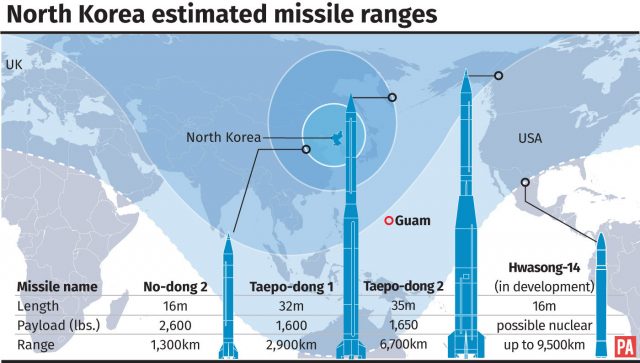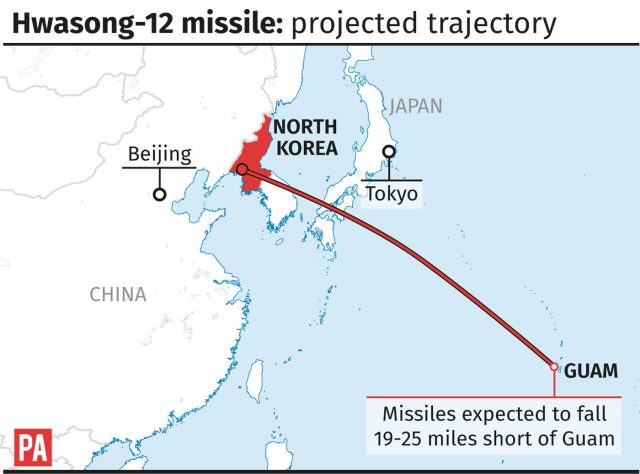
North Korea has announced a detailed plan to launch a salvo of ballistic missiles towards the US Pacific territory of Guam, a major military hub and home to American bombers.
If carried out, it would be the North’s most provocative missile launch to date.
The announcement on Thursday warned that the North is finalising a plan to fire four of its Hwasong-12 missiles over Japan and into waters around the tiny island, which hosts 7,000 US military personnel on two main bases and has a population of 160,000. Japan and South Korea vowed a strong reaction if the North were to go through with the plan.
The statement said the plan, which involves the missiles hitting waters 30 to 40 kilometres (19 to 25 miles) from the island, could be sent to leader Kim Jong Un for approval within a week or so. It would be up to Kim whether the move is actually carried out. It is unclear whether – or exactly why – North Korea would risk firing missiles so close to US territory.
Such a launch would almost compel the United States to attempt an intercept and possibly generate further escalation.
North Korea, no stranger to bluffing, frequently uses extremely bellicose rhetoric with warnings of military action to keep its adversaries on their heels. It generally couches its threats with language stating it will not attack the United States unless it has been attacked first or has determined an attack is imminent. But the statement raised worries amid threats from both sides.
 An estimate of how far North Korea’s missile can reach (PA Graphics)
An estimate of how far North Korea’s missile can reach (PA Graphics)
Following reports that US intelligence suggests the North might be able to pair a nuclear warhead with a missile capable of reaching targets on the United States mainland, President Donald Trump warned North Korea that “it faces retaliation with fire and fury unlike any the world has seen before”.
Pyongyang, meanwhile, has been louder in its complaints against a new and tough round of sanctions imposed by the United Nations, with strong US backing, and Washington’s use of Guam as a staging ground for its stealth bombers, which could be used to attack North Korea and are a particularly sore point with the ruling regime in Pyongyang.
Its reported plan is extremely specific, suggesting it is actually plotting a launch. The report said the Hwasong-12 rockets would fly over Shimane, Hiroshima and Koichi prefectures in Japan and travel “1,065 seconds before hitting the waters 30 to 40 kilometres away from Guam”. It said the Korean People’s Army Strategic Force will finalise the plan by mid-August, present it to Kim Jong Un and “wait for his order”.
My first order as President was to renovate and modernize our nuclear arsenal. It is now far stronger and more powerful than ever before….
— Donald J. Trump (@realDonaldTrump) August 9, 2017
“We keep closely watching the speech and behaviour of the US,” it said.
Such a move would not merely be a test launch, but a demonstration of military capabilities that could easily lead to severe consequences.
South Korea’s military responded by saying North Korea will face a “stern and strong” response from Washington and Seoul. Taking it a step further, Japan’s defence minister Itsunori Onodera told parliament a missile attack on the US territory would be a Japanese national emergency because it would threaten Japan’s existence as a nation.
 Projected trajectory of the Hwasong-12 missile (PA Graphics)
Projected trajectory of the Hwasong-12 missile (PA Graphics)
If North Korea were to actually carry it out – even if it aimed at hitting the waters off Guam and not the island itself – that would clearly pose a potential threat to US territory and put the United States in a much more complicated situation than it has been during previous missile launches.
Guam lies about 3,400 kilometres (2,100 miles) from the Korean Peninsula, and it is extremely unlikely Kim’s government would risk annihilation with a pre-emptive attack on US citizens.
It is also unclear how reliable North Korea’s missiles would be against such a distant target, but no-one was writing off the danger completely.


Why are you making commenting on The Herald only available to subscribers?
It should have been a safe space for informed debate, somewhere for readers to discuss issues around the biggest stories of the day, but all too often the below the line comments on most websites have become bogged down by off-topic discussions and abuse.
heraldscotland.com is tackling this problem by allowing only subscribers to comment.
We are doing this to improve the experience for our loyal readers and we believe it will reduce the ability of trolls and troublemakers, who occasionally find their way onto our site, to abuse our journalists and readers. We also hope it will help the comments section fulfil its promise as a part of Scotland's conversation with itself.
We are lucky at The Herald. We are read by an informed, educated readership who can add their knowledge and insights to our stories.
That is invaluable.
We are making the subscriber-only change to support our valued readers, who tell us they don't want the site cluttered up with irrelevant comments, untruths and abuse.
In the past, the journalist’s job was to collect and distribute information to the audience. Technology means that readers can shape a discussion. We look forward to hearing from you on heraldscotland.com
Comments & Moderation
Readers’ comments: You are personally liable for the content of any comments you upload to this website, so please act responsibly. We do not pre-moderate or monitor readers’ comments appearing on our websites, but we do post-moderate in response to complaints we receive or otherwise when a potential problem comes to our attention. You can make a complaint by using the ‘report this post’ link . We may then apply our discretion under the user terms to amend or delete comments.
Post moderation is undertaken full-time 9am-6pm on weekdays, and on a part-time basis outwith those hours.
Read the rules here